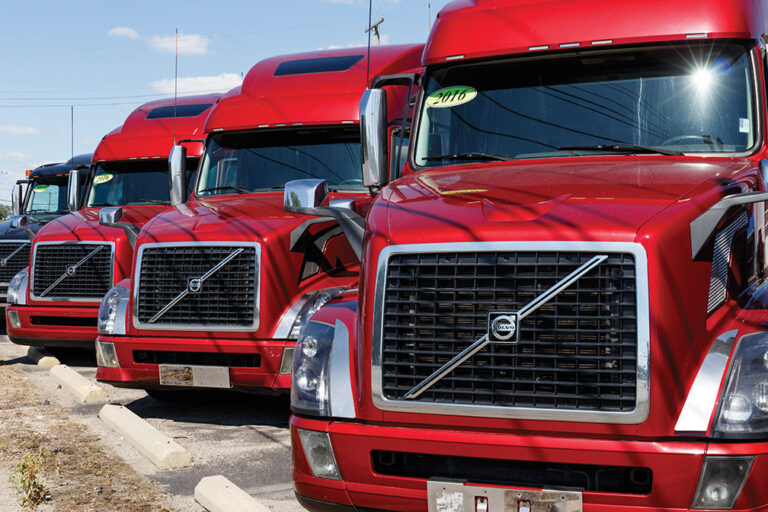U.S. sales of Class 8 trucks remain subdued in August with sales of 18,176 reported by manufacturers, according to data received from Wards Intelligence.
The August result was 8% higher than July sales of 16,824 and 2.8% better than August 2020 sales, both well below normal production levels. In August 2020, only 17,685 Class 8 trucks were sold as the industry was returning to normal after COVID-19 shutdowns and restrictions.
For comparison, in 2019, an average of 23,032 Class 8 trucks were sold each month, with 23,466 sold in August of that year — 5,290 more than this year for a 2021 decline of 22.5%.
There isn’t a direct correlation between sales and production, of course. When assembly lines are running at full capacity and sales aren’t keeping up, excess inventory builds up at dealers and factories. For months, the opposite occurred in the U.S. as truck sales exceeded production, relying on existing inventories to make up the difference.
Currently, there isn’t much inventory left to draw from, and what’s left is often designed for unique applications, such as off-road.
In the meantime, the backlog of orders extends well into next year, and build slots for 2021 models are filling fast.
“The order average, breaking through 35,000 per month in July, is currently pointing to monthly build volumes that should be approaching 30,000 units per month. Instead, production through July has failed to crack the March build rate, and July build totaled just 14,920 units, or 710 units per day, as the OEMs resorted to down days and weeks,” said Kenny Vieth, president and senior analyst at ACT Research, regarding the Sept. 10 release of ACT’s latest “North American Commercial Vehicle OUTLOOK.”
An earlier ACT release, on Sept. 2, reported 31,900 North American orders in August, more than double the July build rate of 14,920 trucks.
Shortages of parts and materials has been the biggest culprit. Semiconductors are in short supply around the world. Consumer electronics sales during the COVID-19 pandemic depleted existing supplies while plants were shut down due to the pandemic. Once the plants reopened, the demand far exceeded production abilities, and competition for chips became fierce.
“In the current period of near-record demand for commercial vehicles of all stripes, the story the past few months has shifted from one of abundance to one of constraint,” Vieth said, noting that semiconductors are only one of many holdups in the supply chain.
“In actuality there are scores of parts that continue to be impacted by the pandemic, by the lingering impact of steel tariffs, and even by the February storm that incapacitated Texas and shutdown swathes of the U.S. plastics industry for two-plus quarters,” he said.
Manufacturers responded by partially manufacturing vehicles, omitting certain components with plans to add the missing parts, once they became available, to complete the build.
Manufacturers of trucks in classes 5, 6 and 7 had the option of diverting chips to Class 8 models. This appears to have happened in August. For the year to date, Class 8 trucks have represented 70.2% of the Classes 5-8 market. In August, that percentage increased to 72.8%.
Freightliner had the largest change, with sales of Class 8 trucks in August representing 72.4% of monthly sales, compared to 64.7% for the year to date.
Truck builders aren’t the only manufacturers dealing with slowed production. Their suppliers also depend on deliveries of the parts and materials they need, including those pesky semiconductors.
Another reason for shortages of vehicle components is the rapidly increasing cost of container shipping. Parts and materials from Europe or China — including everything from electronic control units to floor mats and mattresses — are used in new Class 8 truck production. COVID-19 closures, weather incidents other issues have resulted in huge backlogs at ports around the world. The resulting delays have caused a capacity imbalance, with more demand for containers than for the ships to haul them.
Just as in trucking, when demand exceeds capacity, shipping rates rise. According to the Drewry World Container Index, the composite cost of shipping one 40-foot container topped the $10,000 mark Sept. 9, increasing a whopping 309% over the price during the same week of 2020.
According to Drewry, the cost of shipping a 40-foot container from Shanghai to Los Angeles rose to $11,569 in the past week, nearly eight times higher than pre-COVID levels.
Those looking to the used truck market to find equipment are likely to find similar issues with available inventory.
“At the heart of the issue is used truck inventory, which continues to lose traction,” said Steve Tam, vice president of ACT, in a late-August release. “Underscoring the point, sales were also down year over year.”
Used truck prices for units sold in July lagged only a few dollars behind those sold in June, but they showed a significant 46% increase from the average price in July 2020. That doesn’t necessarily mean the price of all used trucks rose 46%, but it could indicate that a different mix of trucks, including newer models, left the market this year.
On an individual OEM basis, only Kenworth and Peterbilt saw declines in sales for August from July numbers. Kenworth’s 2,861 trucks sold in the month were 5.6% lower than July sales of 3,031 but 20% better than August 2020 sales of 2,385. Peterbilt’s 2,605 sold declined by 130 trucks (4.8%) from July but bested August 2020 sales of 2,428 by 7.3%
International sales of 2,867 represented an improvement of 244 trucks for a 9.3% increase. Compared to August 2020, sales increased by 588 (25.8%).
Volvo sales jumped by 305 trucks from July to August, an increase of 34.3%. Compared to August 2020, however, results were down by 678 trucks (36.2%).
Mack’s 1,495 trucks sold in August topped July sales of 1,252 by 19.4% and bested August 2020 sales by 46.4%.
Freightliner sold 6,646 trucks in August, 13.7% better than July but 8.5% worse than August 2020.
Market shares for the year to date are as follows: Freightliner, 38.2%; Peterbilt, 15.3%; Kenworth, 14.7%; International, 12.6%; Volvo, 8.7%; Mack, 7.9%; and Western Star, 2.6%.
Both production and sales of over-the-road Class 8 trucks are expected to remain constrained for the next few months.
Cliff Abbott is an experienced commercial vehicle driver and owner-operator who still holds a CDL in his home state of Alabama. In nearly 40 years in trucking, he’s been an instructor and trainer and has managed safety and recruiting operations for several carriers. Having never lost his love of the road, Cliff has written a book and hundreds of songs and has been writing for The Trucker for more than a decade.








